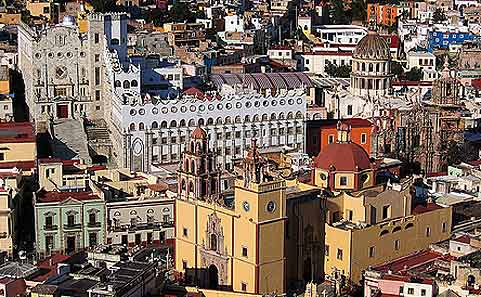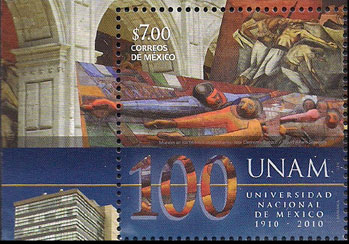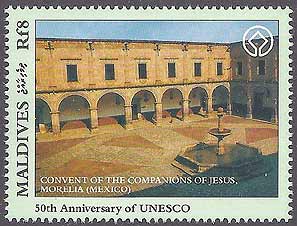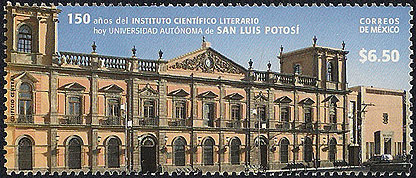Loreto, Baha California

MEXICO, 1997, the tercentenary of Loreto, Scott 2063
The California missions, dating from 1769, are usually associated with the Franciscans and especially with St. Junípero Serra. But the first permanent mission, Misión Nuestra Señora de Loreto Concho in Baja California, was founded seventy-three years earlier, on October 25, 1697, by Fr. Juan Maria Salvatierra, SJ (1648-1717). A sign over the entry door reads Head and mother of all the missions of upper and lower Californias. Over the next 70 years Jesuits founded another 17 missions along the Camino Real, but at their Suppression the work was given to the Franciscans. Born in Milan, Salvatierra became interested in the Indian missions while studying with the Jesuits in Parma. He entered the Jesuits, came to Mexico in 1675, and continued his theological studies there. He worked first in southwest Chihuahua, was visitor of the missions of Pimeria (1690-91), rector of the college at Guadalajara (1693-1696) and master of novices (1696) and finally that year , moved by conversations with Father Eusebio Kino began to evangelize Lower California. Salvatierra and a few soldiers landed at Concepcion Bay and founded the first of the California missions, dedicated to Our Lady of Loreto. More
The Jesuit Church and College of the Holy Trinity, Guanajuato
MEXICO, 2012, the 280th anniversary of the University of Guanajuato, Scott 2807While the first 15 Jesuits in Mexico landed at Veracruz in 1572, the Universidad de Guanajuato had its beginnings in the Hospice of the Holy Trinity, on 1 October 1732, and made their residence in the home of Doña Josefa Teresa de Busto y Moya, both donated to them by her as their principal benefactor. In 1744, the Spanish Crown granted the hospice a license to operate as a college, and it became the College of the Holy Trinity, a Jesuit institution offering courses in arts and letters. Its buildings are now occupied by the University of Guanajuato.
The construction of the Church of La Compañía de Jesús began on July 26, 1747, and the adjacent building which would be the new home of the college began on October 29, 1759. In June, 1767 the Jesuits were expelled from New Spain and construction of the college was suspended, with only one floor having been built. The church's interior has three huge naves divided by eight columns. The original dome collapsed in 1808. In 1869, the architect Herculano Ramírez began the total reconstruction which finished January 26, 1884. Some regard the church as one of the best representations of the "evolution" of the Churrigueresque style in Mexico. One of its treasures is a collection of paintings, among the artists Juan Patricio Morlete, Baltazar Echave Oreo, and Miguel Cabrera.
ANTIGUA & BARBUDA, 1997, this souvenir sheet celebrating the 50th anniversary of UNESCO, features five Jesuit institutions:
the Mission of the Most Holy Trinity in Paraguay (bottom left);
and the Church of St. Peter Claver in Cartagena, Colombia (bottom center);
the Jesuit Missions of the Chiquitos in Bolivia;
the Jesuit Church and College in Guanajuato, Mexico (top left and right), Scott 2054

The stamp to the left centers on the University of Guanajuato, with its massive facade and staircase;
the stamp to the right shows the dome of the Jesuit church, its facade and bell tower behind;
the photo below shows how they relate to each other and the red-domed Basilica of Our Lady of Guanajuato.
The light blue building between university and church is of newer construction.
College of Saints Peter and Paul, Mexico City

MEXICO, 1982, Colonial Monument
Series, Scott 1303
The College of Saints Peter and Paul in Mexico City was the ancient School of Theology for the Province of Mexico.
Iberoamerican University, Mexico City


MEXICO, 2003, 60th anniversary of the university, Scott 2307
MEXICO, 2013, 70th anniversary of the university, Scott 2812
The Universidad Iberoamericana was founded in 1943 by the Jesuits as a School of Philosophy and Literature. It was chartered in 1954 as the Universidad Iberoamericana. The university moved to its modern campus in the Santa Fe area of Mexico City in 1988.
Instituto Científico de San Francisco de Borja, Mexico City
MEXICO, 1981, Scott 1260Between the years 1766 and 1771 José Vivanco Hurtado de Mendoza, seventh Count of Valle de Orizaba, built a summer mansion that was unfinished at the time of his death. In 1822, still unfinished, it was acquired and completed in a different style from the original. Known commonly as the Casa de los Mascarones (house of the figureheads) because of its decoration, it functioned repeatedly as an educational institution, harboring in 1850 the Colegio de San Luis, in 1871 the Colegio de Nuestra Señora de Guadalupe, and in 1892 or 1893 the Instituto Científico de San Francisco de Borja run by the Jesuits at the request of parents who had acquired the building to give their children a first-class and Christian education. By the turn of the century students referred to themselves as going to the Casa de Los Mascarones rather than using the real name of the Instituto Científico. In 1914, however, the building was seized by the government, the school closed and the Jesuits expelled.
San Ildefonso College, Mexico City


MEXICO, 1985, 75th anniversary of the University of Mexico, Scott 1404
MEXICO, 1993, 125th anniversary of the National Preparatory School, Scott 1843

MEXICO, 2010, the centenary of UNAM, stamps from the souvenir sheet (see below), Scott 2695b, 2695d
one stamp showing the facade of the old school, the selvage and other stamp show its porticoes
The Antiguo Colegio de San Ildelfonso once occupied a building now used by the University of Mexico and National Preparatory School in Mexico City, shown on the stamps above. The school was founded by the Jesuits in 1588. Its graduates assumed key positions in New Spain. After the Jesuits were expelled their property was confiscated by the government. From 1910 to 1978 the building was the home of the National Preparatory School, and in the 90s after years of disuse it became a museum.
The Jesuit Residence, Morelia
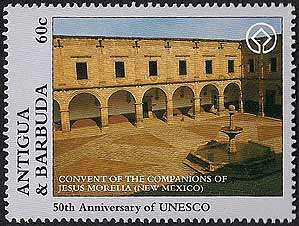
ANTIGUA, 1997 World Heritage Series, Scott 2048
MALDIVES, 1997 World Heritage Series, Scott 2237eMorelia, founded as the City of Michoacan, was renamed first Valladolid in 1545, and then Morelia in 1828. It is in Mexico, not New Mexico as the stamp states. The Jesuit complex includes the College of St. Francis Xavier, the Jesuit residence and the church—the Iglesia de la Compañía—built between 1660 and 1681. It is now called the Palacio Clavijero, named for the famous Jesuit priest-historian Francisco Javier Clavijero, who taught here beginning in 1764. His work and all Jesuit activity here ceased, of course, with the expulsion of the Society in 1767. The building, a majestic example of mid-17th century Baroque architecture, later served as a correctional facility for priests, and in 1824, it became the home of the Congress of Michoacan. Restored in 1970, it is now the site of the tourism office, public library and government offices, with the famous Mercado de Dulces (Candy Market) located on its west side.
The Jesuit College, Puebla
MEXICO, 1987, 50th anniversary of the Autonomous University of Puebla, Scott 1477The Jesuits arrived in Puebla in 1578 and founded several colleges there. The stamp shows a detail of an ancient building of one of them. The building is on Avenue 4 Sur next to the Iglesia del Espiritu Santo (also called the Holy Spirit Church or "La Compañia"). This 18th-century church built on the location of the first Jesuit Church was ironically not completed until 1767, the year the Jesuits were expelled from Mexico.
The Autonomous University of San Luis Potosí
MEXICO, 2009, the 150th anniversary of the university, Scott 2638In 1624 the Jesuits established in the city of San Luis Potosí, the capital of the Mexican state of San Luis Potosí, a school where they taught for almost a century and a half until their expulsion on June 25, 1767. The Instituto Científico y Literario was founded on the basis of that Jesuit college and was raised to the category of a university in 1923. Today as the Universidad Autónoma de San Luis Potosí it is recognized as one of Latin America's best universities.



